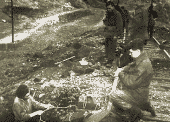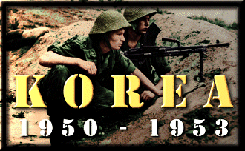The War At Sea

The Korean War was principally a land war, with air support being provided by the UN Air Forces and aircraft carrier based fighters and strike aircraft, with air-sea rescue facilities being provided by US and RAF flying boats. At the start of the war, the British Commonwealth formed a Commonwealth Task Force which included six light fleet carriers, seven cruisers, eight destroyers, fourteen frigates, two submarines and two depot ships from the Royal Navy together with a fleet train of twelve tankers and a hospital ship. The main effort of the Royal Navy was involved in providing air and ground support for the troops ashore, air reconnaissance and patrols, and interdiction of enemy air strikes by the new Hawker Sea Furies and Fairey Fireflies, while the cruisers, destroyers and frigates provided naval gunfire support.
At the beginning of the war, the Far Eastern Fleet was in a parlous state, having suffered from post-war cutbacks so that the Mediterranean Fleet could be built up. To bring the fleet up to its wartime complement, reservists were called up and men about to retire were kept on for the duration of the emergency. Throughout the war, the Commonwealth Task Force kept at least one carrier on station around Korea, while another was nearby, being refitted or resupplied. During their tours in Korea, the carriers would frequently stop at Malaya to help out the troops engaged there against the Malayan Communist Party. In September the Commonwealth navies contributed warships and support vessels to the Inchon Landings.

The Navy also encountered large numbers of mines laid by the North Koreans. The massive lack of functional minesweepers caused the Navy to deploy its first helicopters in the anti-mine role aboard H.M.S. Theseus late in 1950. The naval operations also included anti-submarine patrols and an enforced blockade of North Korea and bombardment of the Communist supply system along the coastal railways and road networks. The Blockade forces had been created in the first days of the war by ships from the US and Royal Navies. In September 1950, the Blockade Force was designated Task Force 95, and was subsequently divided into two. TG 95.1 on the West Korean Station and TG 95.2 on the East Korean station. TG 95.2 was under the command of a British rear-admiral for most of the war and three light fleet carriers, H.M.S. Triumph, H.M.S. Glory and H.M.S. Ocean, were a major part of these operations for most of the war. Photo of H.M.S. Theseus courtesy of Battleships Carriers And All Other Warships The Anchor Page For The World's Warships (no longer exists).

After the Chinese intervention, UN Navies successfully evacuated X Corps from Northeast Korea. A second amphibious operation along the lines of Inchon was ruled out as a response to the Chinese counter-attack. The North Korean east coast ports of Wonsan, Hungnam and Songjin were besieged by UN Naval forces and tied up large numbers of troops and heavy equipment from 1951 to the day the armistice was signed. Wonsan had a cluster of islands in the outer harbour which was continuously garrisoned by UN troops throughout the war, including British Royal Marines. South Korean Marines were landed on other islands and supported by vessels of TF 95. These islands functioned as electronic and signals intelligence bases as well as air-sea rescue bases. The islands were abandoned after the armistice, but not before the evacuation of thousands of .anti-communist guerillas from North Korea.



